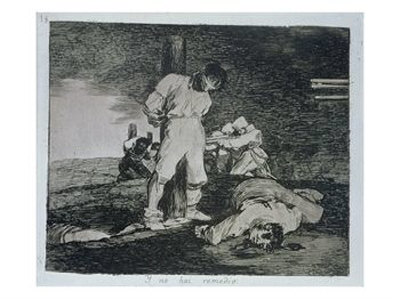To honour the fortieth anniversary of the founding of Amnesty International, today’s picture is one of Francisco Goya’s dark meditations on man’s inhumanity to man. Bleakly entitled And There’s No Help For It, this image of brutal and summary execution was inspired by atrocities carried out during the Napoleonic invasion and occupation of Spain in the early nineteenth century. It is one of a group of 85 etchings collectively known as The Disasters of War. Goya’s designs were considered both too desolate and too politically inflammatory to be published in the artist’s own lifetime, so relatively few examples were printed under his supervision. The impression reproduced here comes from the so-called Cean Bermudez album in the British Museum, a proof copy given by Goya to a close friend, which is the fullest and best preserved version of the Disasters. The title page of the leather-bound volume bears an inscription written in the artist’s own hand: “Fatal consequences of the bloody war in Spain with Bonaparte”
Goya was in his early sixties when “the bloody war” broke out. In early 1808, when Charles IV of Spain abdicated in favour of his son, Ferdinand, Napoleon decided that the time had come to supplant their Bourbon dynasty with his own. While his troops marched on Madrid, the French emperor summoned the entire royal family to Bayonne and informed them that he was seizing power. They submitted meekly to the news and Napoleon’s brother, Joseph Bonaparte, was proclaimed King of Spain in June. Meanwhile, the citizens of Madrid rioted violently against the French occupying forces, who responded by massacring the insurgents in their thousands. As news of these events filtered through to the rest of Spain, province after province rose up against the invaders. It was to be the start of...

ITP 62: And There’s No Help For It by Francisco Goya
24-06-2001

